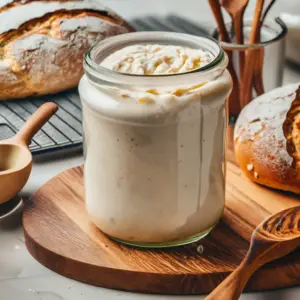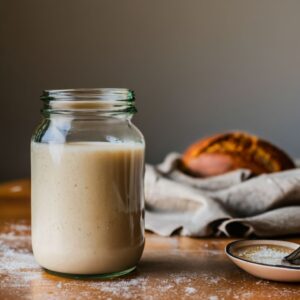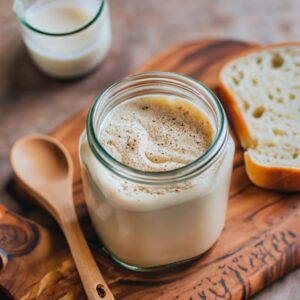
Embark on a journey of homemade bread-making with our simple and rewarding Sourdough Starter Recipe. Sourdough, with its distinctive tangy flavor and airy texture, has captivated bakers for centuries with its natural leavening properties and health benefits. In this guide, we’ll walk you through the steps to create and nurture your own sourdough starter, from the initial mixing of flour and water to the daily feeding and maintenance. Join us as we delve into the art and science of sourdough fermentation, empowering you to craft delicious breads and baked goods right in your own kitchen.
what is sourdough starter
A sourdough starter is a natural leavening agent created by fermenting a mixture of flour and water. It contains wild yeast and lactobacilli bacteria, which help dough rise and develop flavor. Sourdough has been used for centuries as a leavening agent in bread-making.
Benefits of Sourdough Starter

- Natural Leavening: Sourdough starter serves as a natural leavening agent for bread and other baked goods, eliminating the need for commercial yeast.
- Unique Flavor Profile: The fermentation process of sourdough starter imparts a distinct tangy flavor to bread, enhancing its taste and complexity.
- Improved Digestibility: Fermentation breaks down gluten and phytic acid in the grains, making sourdough bread easier to digest for some individuals compared to bread made with commercial yeast.
- Lower Glycemic Index: Sourdough bread has a lower glycemic index than bread made with commercial yeast, resulting in slower glucose release and potentially more stable blood sugar levels.
- Preservation: Sourdough starter can be perpetuated indefinitely with regular feeding, making it a sustainable and cost-effective method for baking bread at home.
- Versatility: Sourdough starter can be used not only for bread but also for a variety of other baked goods such as pancakes, waffles, and pizza dough, adding flavor and texture.
- Health Benefits: Some studies suggest that the lactic acid bacteria present in sourdough starter may have probiotic properties, contributing to gut health and overall well-being.
- Artisanal Appeal: Baking with sourdough starter allows for a hands-on and artisanal approach to breadmaking, fostering a deeper connection with the baking process and resulting in unique and flavorful loaves.
sourdough starter recipe

Ingredients for Sourdough Starter Recipe:
| Ingredient | Quantity |
|---|---|
| Whole Grain Rye Flour | 100 grams (3/4 cup) |
| Whole Wheat Flour | 100 grams (3/4 cup) |
| All-Purpose Flour | 100 grams (3/4 cup) |
| Room Temperature Water | 100 grams (1/2 cup) |
how to make sourdough starter
- Mix equal parts whole wheat or rye flour and water in a jar.
- Let the mixture ferment at room temperature for 24 hours.
- Discard half of the starter and feed it with equal parts flour and water.
- Repeat the feeding process daily until the starter is active and bubbly.
tips for making sourdough starter
- Use filtered or dechlorinated water to avoid inhibiting yeast growth.
- Maintain a consistent feeding schedule to keep the starter healthy.
- Be patient, as it may take several days for the starter to become active.
- Keep the starter in a warm environment, ideally between 70-75°F, for optimal fermentation.
- Use a clear glass jar and a digital kitchen scale for precise measurements and monitoring.
customization ideas for the Sourdough Starter Recipe
Here’s a table outlining some customization ideas for the Sourdough Starter Recipe:
| Customization | Description |
|---|---|
| Flour Variations | Experiment with different types of flour such as spelt flour, einkorn flour, or even gluten-free alternatives like rice flour. |
| Liquid Additions | Add flavor and depth to your starter by incorporating ingredients like honey, molasses, or fruit juices. |
| Herb and Spice Infusions | Infuse your starter with herbs like rosemary or thyme, or spices such as cinnamon or cardamom for unique flavor profiles. |
| Seed and Nut Mix-Ins | Enhance the texture and taste of your starter by mixing in various seeds and nuts like pumpkin seeds or chopped almonds. |
| Fermentation Time | Adjust the fermentation time to develop different levels of sourness and acidity in your sourdough starter. |
| Temperature Control | Experiment with fermenting your starter at different temperatures to influence its development and flavor profile. |
This table provides ideas for customizing your sourdough starter recipe, allowing you to tailor the flavor and characteristics of your starter to suit your preferences.
sourdough starter names
Naming your sourdough starter can add a personal touch to your baking experience. From whimsical to traditional, the names reflect the unique character of each starter and the baker’s creativity, making the process more enjoyable and personal.
- Doughseph
- Yeasty Beastie
- Fermento
- Rise & Shine
- Breadzilla
- Cultured Companion
- Flour Power
- Lively Loaf
- Rise & Grind
- Wild Yeast Wonder
why is my sourdough starter not rising
If your sourdough starter is not rising, it may need more time to develop or consistent feeding. Factors such as temperature, flour type, and water quality can affect the fermentation process. Be patient and continue feeding your starter until it becomes active and bubbly.
By following these steps, you can create your own sourdough starter at home and enjoy delicious homemade bread with unique flavor and texture.
When is Your Sourdough Starter Ready To Use
Your sourdough starter is deemed ready for use once it exhibits the following indicators:
- Doubling in size, signifying bulk growth
- Presence of both small and large bubbles on the surface and throughout the culture
- Achieving a spongy or fluffy texture
- Emitting a pleasant aroma, devoid of unpleasant scents like nail polish remover, gym socks, or rubbing alcohol
To aid in identifying these signs, consider placing a rubber band around the base of the jar to gauge the starter’s growth. Additionally, you can conduct the float test by dropping a small dollop of starter into a glass of water. If it floats to the top, your starter is primed for use.
How to Store Your Sourdough Starter

How to Store Your Sourdough Starter Upon establishing your starter, you have two storage options:
At Room Temperature: If you frequently engage in baking, opt to store your starter at room temperature. This accelerates fermentation, fostering a bubbly, active starter that is readily available for use. Maintain room temperature starters by feeding them once or twice daily, based on their rate of rise and fall.
In the Fridge: For those who bake less frequently, refrigeration is suitable. Simply cover your starter with a lid and store it in the fridge. Maintenance involves feeding the starter approximately once a week to sustain its strength during periods of inactivity. When preparing to use the starter, feed it at room temperature as needed to reactivate it.
FAQ’S
What is a sourdough starter?
- A sourdough starter is a mixture of flour and water that has fermented and developed wild yeast and bacteria cultures. It serves as a natural leavening agent for sourdough bread and other baked goods.
How is a sourdough starter different from commercial yeast?
- Unlike commercial yeast, which is a single strain of yeast, sourdough starter contains a combination of wild yeast and bacteria. This results in a longer fermentation process and imparts a unique flavor profile to the bread.
How long does it take to create a sourdough starter?
- Creating a sourdough starter typically takes about 5 to 7 days, depending on factors such as room temperature, flour type, and feeding schedule.
What signs indicate that a sourdough starter is ready to use?
- A sourdough starter is ready when it has doubled in size, exhibits small and large bubbles throughout, has a spongy or fluffy texture, and emits a pleasant aroma. Additionally, it should pass the float test, where a small amount of starter floats in water.
How should I store my sourdough starter?
- Sourdough starter can be stored at room temperature or in the refrigerator. At room temperature, it should be fed once or twice daily, while in the refrigerator, it can be fed weekly.
Can I customize my sourdough starter?
- Yes, you can customize your sourdough starter by using different types of flour, adjusting the feeding schedule, or incorporating additional ingredients like fruit juice or honey for flavor variations.
What do I do if my sourdough starter doesn’t seem active?
- If your sourdough starter appears sluggish or inactive, try adjusting the feeding schedule, using warmer water, or allowing it more time to ferment. If problems persist, you may need to discard and restart the starter.
Can I use my sourdough starter straight from the refrigerator?
- Yes, you can use a refrigerated sourdough starter directly in recipes, but it’s recommended to bring it to room temperature and feed it before incorporating it into your dough for optimal results.
How long can I keep my sourdough starter?
- With regular feeding and maintenance, a sourdough starter can be kept indefinitely. Some starters have been passed down through generations!
Can I use whole wheat flour to create a sourdough starter?
- Yes, whole wheat flour can be used to create a sourdough starter, and it may result in a stronger starter due to its higher nutrient content compared to refined flour.
